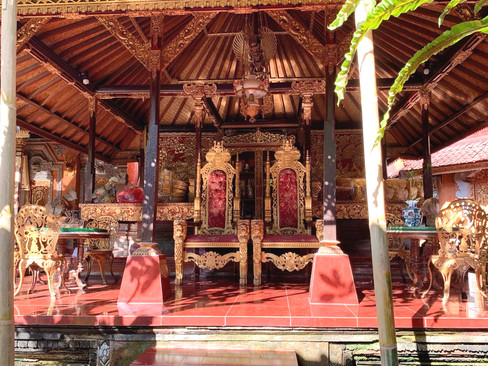The Royal Palace of Ubud
- Shannon
- Sep 17
- 3 min read
The Heart of Ubud's Royal Heritage
The Ubud Royal Palace, known as Puri Saren Agung, is an iconic historical site in Bali, situated in the heart of Ubud. The palace traces its origins to around 1640 when it was first constructed as a residence for a branch of Ubud's royal family. Over time, it evolved into the majestic structure we see today, largely due to the significant contributions of King Ida Tjokorda Putu Kandel during the early 1800s.

By the 17th century, Bali experienced a rapid emergence of new kingdoms, including the founding of several royal houses in Ubud. The King played a pivotal role in shaping the palace’s present form. His reign marked a time of expansion and prosperity for Ubud and under his leadership, the palace became not only the residence of the royal family but also a symbol of the cultural and artistic heart of Bali. This period however also saw much conflict between royal clans. The Royal Palace was strategically placed in the centre of Ubud, making it the focal point of the Kingdom's political and social life.

The construction of the Palace attracted skilled artisans from across Bali, who contributed to its intricate design and craftsmanship. Once completed, many of these artists chose to stay in Ubud, which began to flourish as a vibrant cultural hub. The village’s fertile land and abundant rice supplies supported a booming economy, while the royal family’s patronage of the arts further fueled Ubud's growth. As a result, Ubud became a major centre for agriculture, art and culture, establishing itself as one of Bali's most prominent and prosperous towns.
In 1917, the Royal Palace suffered significant damage during a 6.6 mag earthquake but was swiftly restored and reopened to foreign guests and local dignitaries by 1928. During this time, many bohemian artists and intellectuals flocked to Ubud, drawn by the palace's cultural influence and the royal family’s support of the arts. These artists often stayed at the palace or in nearby compounds, where they entertained the royal family with their work. This influx of creative individuals helped establish Ubud as a vibrant artistic hub and the practice of staying with local families. This laid the foundation for the homestay tradition in the city, which continues to attract visitors seeking an immersive cultural experience.
In addition to hosting nightly cultural performances that showcase Bali’s artistic traditions, the palace compound is a hub for the preservation and celebration of Balinese culture, providing a space for the local community and visitors to engage with traditional arts, dance and literature. It houses a variety of performances and events that highlight the unique forms of Balinese expression, from traditional gamelan music and vibrant dance performances to dramatic theatrical works. As a cultural repository, the palace also plays an important role in the education and transmission of these art forms, ensuring they remain vital for future generations.

The palace remains a living testament to Bali’s rich royal heritage, as descendants of the original royal family still reside within its walls. These descendants continue to maintain a connection to the palace’s traditions. The palace is surrounded by meticulously maintained gardens that reflect the serene and artistic atmosphere of Ubud and offers a rare blend of history, culture and personal connection that makes visiting Puri Saren Agung a memorable and enriching experience.
The palace was the brainchild of a progressive King who had a passion for the arts
🗺️ Location
Jalan Raya Ubud No 8, Ubud Village, Gianyar Regency, Bali, Indonesia
🚆 How to get there
All visitors are welcome to enter the Ubud Royal Palace for free and it is open between 9am and 6pm everyday, except on Nypei. The palace also serves as a venue for nightly cultural performances and traditional dances. These performances start at 7:30pm and tickets cost 100,000 IDR. The show finishes at 9pm.
⭐ Attraction Info
The palace is located on the Main Street in the heart of downtown Ubud, directly opposite the famous art market. It is easily reached by foot and very hard to miss.


























